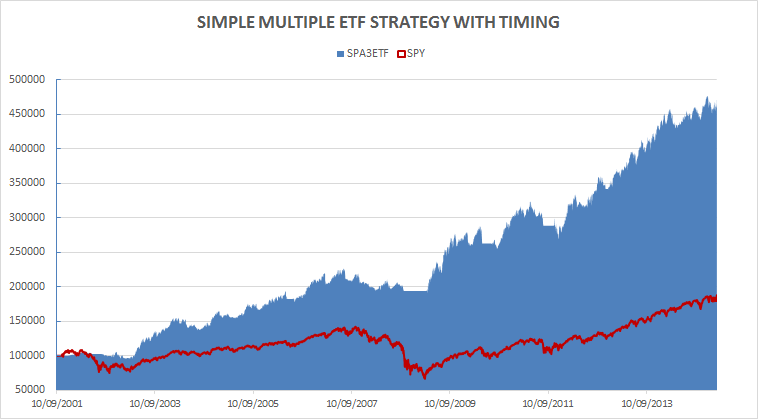Our initial discussions on using ETFs began with the concept of a single ETF that tracks a major global equity index such as the S&P500 (SPY) or the S&PASX 200 (STW) indices and how that even this simple strategy with dividends without any ‘timing’ could outperform 70% of active fund managers, on average over the long term!
We then looked at using timing with this simple strategy and showed how returns could be significantly enhanced. Last week we looked at further advancing our use of ETFs AND improving our returns still further through the use of a multiple ETF strategy that spread risk and exposure across a basket of 5 ETF’s, but was essentially a ‘buy and hold’ strategy that employed no timing or technical analysis tools. This approach achieved an annualised compounded growth of 9.28%, excluding dividends and using no leverage to outperform the S&P500 Index by 4% compounded annually.
The next logical step in our ETF journey is to take the same 5 ETFs included in last weeks ‘buy and hold’ exercise and introduce some simple timing techniques to ‘actively manage’ the portfolio rather than just sit on our chosen basket and hang on for the ride. The 5 ETFs included in this basket are the Mexican Bolsa, German DAX, NASDAQ 100, S&P600 Small Cap and NASDAQ Biotechnology Sector. (ETF codes are EWW, EWG, QQQ, IJR and IBB).
Running this ‘timing’ strategy across these same 5 ETFs, but still using no leverage, achieved an annualised compounded growth rate of 12.26% (excluding dividends) and would have grown our $100,000 starting capital to over $461,000. This is a big improvement on the buy and hold strategy on the same 5 ETFs shown last week which would have grown our capital from $100,000 to $329,000 over the same period.
And the following equity curve
Importantly, as well as improving our overall compounded annual return from 9.28% to 12.26%, we have also managed to reduce the severity of the drawdown from -53% to -17% by ‘going to cash’ when any sell signals were generated.
This simple, yet highly effective approach has made a significant, positive impact on our overall net worth, not to mention our mental and psychological state as we have been able to exit the market and sit on the sidelines during severe price retracements. We can then re-enter the market when any new buy signal is generated, taking advantage of the next upward price move.
With just a little effort of doing 9 trades a year over the 13.5 years we’ve been able to massively improve results while taking much less risk during big market downturns compared to the buy and hold.
In a future blog, we will look at boosting our results still further using timing of a multiple ETF strategy of a basket of ETFs AND the use of reasonable leverage to increase our exposure to ETFs when a buy signal is generated.



